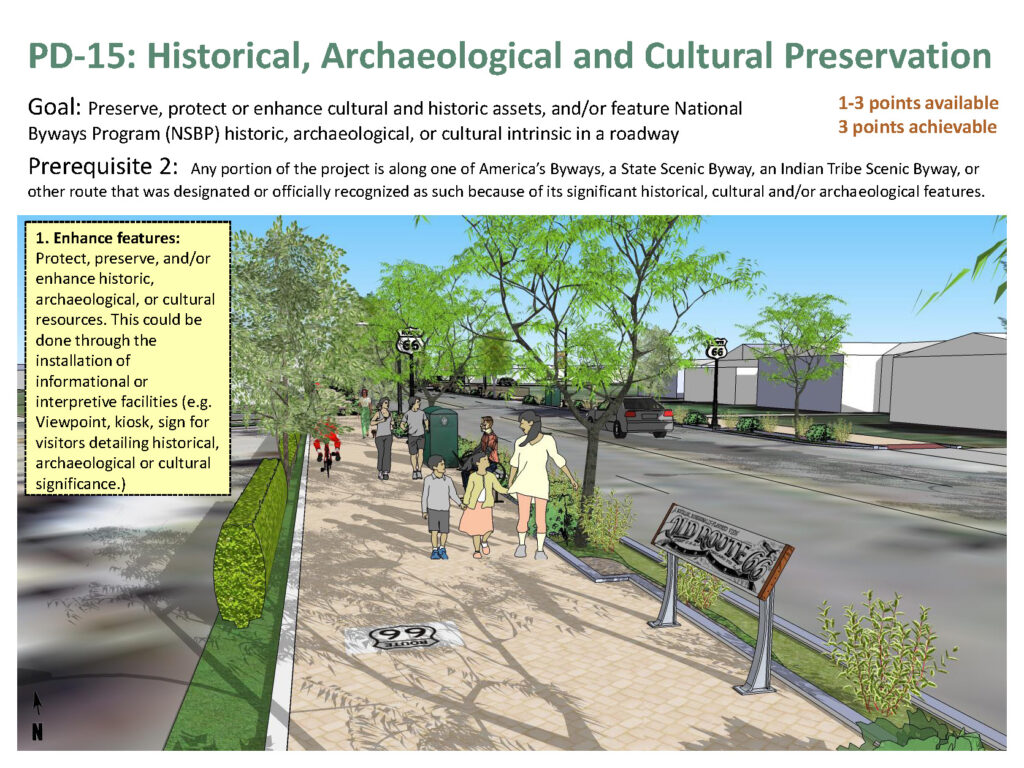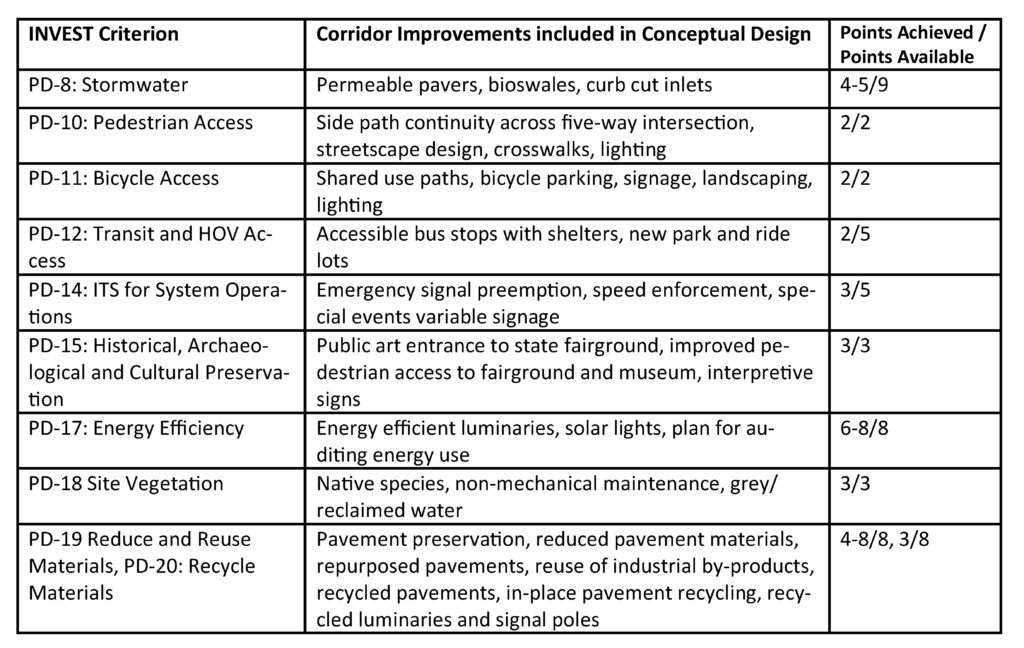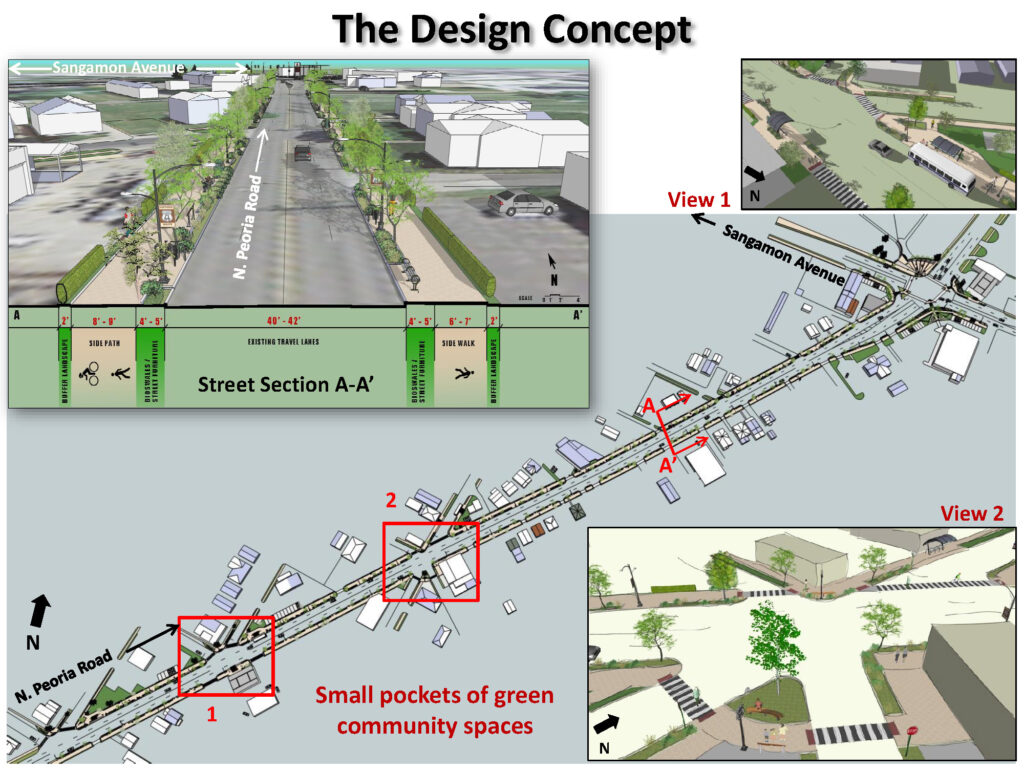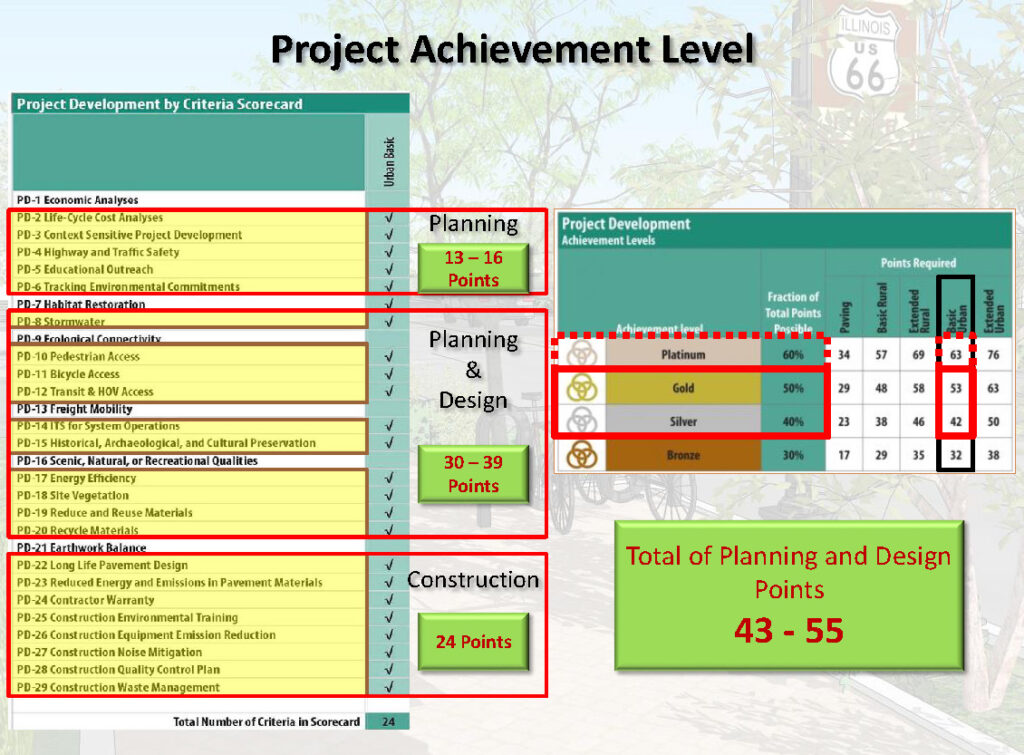Demonstrating INVEST – A Sustainability Tool by FHWA
Visualizing Sustainability in the Historic Route 66 Corridor Project, Springfield, IL

MY ROLE: Project Team Leader & Speaker
My role as a Team Leader for INVEST project primarily involved demonstrating the application of sustainability principles using INVEST (Infrastructure Voluntary Evaluation Sustainability Tool) by the Federal Highway Administration (FHWA) to holistically envision a Corridor Development Project on a real site. The project was presented to local leaders, the development community, and the public. The tool was prospectively used to conceptualize the redevelopment of a historic Route 66 corridor through Springfield.
As a federally designated Metropolitan Planning Organization (MPO) for transportation planning in the region, the idea of using this tool at the detailed project level was to encourage and hopefully inspire other MPOs, member jurisdictions, and local communities to start thinking beyond the normal standard of planning practice of a road development/improvement project to develop an understanding of the application of sustainability concepts in transportation planning and development. The best possible way to do this was to holistically visualize what the corridor and the place would look like using INVEST. It needed a fresh approach. The elements of the tool were integrated into the project context at an early concept stage and used transportation planning, urban design, and sustainability principles to envision the project.
PROJECT OUTCOME
The project has been presented at various levels including the AMPO (Association of Metropolitan Planning Organizations) Annual Conference 2013 in Portland (OR), IDOT Fall Planning Conference 2015, and at various local levels. Initially, the project was presented to Springfield Area Transportation Study members comprising of representatives from local, state, and federal agencies and communities that direct and oversee the transportation planning process for the region. The intent was to educate and raise awareness about sustainability concepts in transportation planning. The presentation was particularly useful in demonstrating the application of this tool to engineers and other officials at IDOT for implementing corridor development projects. Due to these efforts, the use of the tool is under consideration by IDOT for redeveloping this corridor as well as for other projects.
PROJECT PRESENTATIONS
Illinois Department of Transportation (IDOT) Fall Planning Conference 2015 – Utilizing INVEST for Plans and Projects
Association of Metropolitan Planning Organizations (AMPO) National Conference (2013) Speaker – FHWA Panel Session – MPO INVEST-ments in Sustainability
National Webinar (2013) Speaker – FHWA, INVEST
CASE STUDY
Project originally published as a Case Study of INVEST on FHWA – Sustainable Highways website – www.sustainablehighways.org (Excerpt below)
Click here to read the original on FHWA website
Springfield INVEST Case Study Pdf
Visualizing Sustainability in the Historic Route 66 Corridor Project, Springfield, IL
Lead Agency: Springfield Sangamon County Regional Planning Commission (SSCRPC)
INVEST Module: Project Development
Links:
Peoria Road / Route 66 Corridor Improvement Project (PPT) (View in slideshow mode to see animation)
Peoria Road/ Route 66 Corridor Improvement Project (PDF)
The metropolitan planning organization (MPO) for Springfield, IL applied criteria from the INVEST Project Development (PD) module to a corridor improvement project along the Peoria Road / Route 66 Corridor. This corridor includes the historic Route 66, the state fairground, the SHEA’s Museum, transit service, and a mix of residential and commercial development. Using the INVEST criteria, planners identified improvements that could be made to the corridor that would enhance sustainability.
For instance, INVEST criterion PD-15: Historical, Archaeological and Cultural Preservation aims to protect or enhance cultural and historic assets. Installing interpretive signs and improving pedestrian access as suggested by the INVEST criterion could enhance the preservation and enjoyment of historic Route 66 and the museum (see Springfield MPO’s artist renderings of these improvements in the figure below). The actions also improve linkage of Historic Route 66 with the State Fairground. The improvements would provide the project with three out of three available points under the INVEST PD-15 criterion.
As another example, INVEST criterion PD-10: Pedestrian Access aims to improve the safety and convenience of pedestrian networks for people of all ages and abilities by providing or enhancing facilities within the project footprint. Springfield MPO identified specific improvements at key locations, such as crosswalks and landscaping, and developed visuals showing the placement of these amenities. These improvements would provide two out of two possible points under the INVEST PD-10 criterion for improving pedestrian safety, comfort, connectivity, and aesthetics and environment.
The MPO held a workshop with stakeholder agencies in the region, including city officials and the state department of transportation. Planners explained how the INVEST tool measures sustainability and how it could be applied to the Peoria Road / Route 66 Corridor Improvement Project. They then showed visuals of each of the key criteria analyzed, outlining very clearly the requirements for receiving points, and showing where improvements could be made at specific locations along the corridor. Images demonstrated what that would look like and how it would improve outcomes in the corridor. Planners also showed before and after visuals with photographs depicting the corridor’s current status, and mock-ups depicting its appearance after installation of the sustainability improvements suggested by the INVEST criteria.
The MPO evaluated 23 of the 29 PD criteria. Examples of criteria highlighted in the evaluation and the corresponding improvements included in the conceptual design appear in the table below. Many of these improvements fall under the rubric of context sensitive solutions and complete streets.
The INVEST evaluation showed that if the sustainability improvements included in the conceptual design were implemented, the project would achieve the Gold or Silver level of the INVEST Basic Urban Project Development scorecard.
Key Outcomes of Using INVEST:
- Developed a conceptual design showing locations for specific sustainability improvements. Improvements included streetscape design, crosswalks, lighting, accessible bus stops with shelters, public art entrance to state fairground, side path continuity across five-way intersection, improved pedestrian access to fairground and museum, ITS upgrades, and vegetation.
- Demonstrated how the improvements would enhance the level of sustainability of the project as measured against a national benchmark.
- Raised interest among stakeholders in implementing sustainability practices.
- Communicated INVEST criteria effectively and concisely through a visual format.
Section of Route 66 showing current conditions (before) and mock-up with sustainability improvements (after)
Before: Section of Route 66 showing current conditions I After: Section of Route 66 showing mock-up with sustainability improvements.











All images copyright and courtesy SSC Regional Planning Commission, Springfield, IL



